(Photo: urbanext.illinois.edu/roses/disease.cfm)
It is unusual to see the insects at work, but they make their presence known by the perfectly round holes cut near the edges of the leaves. These leaf pieces are used to make egg partitions inside their burrows. The damage they cause is strictly cosmetic and warrants no control.
Exercises
Task 1: Read part 4.1 and complete the information below.
Appearance | Remedy | |
Aphids | ||
Japanese Beetles | ||
Leaf Cutter Bees |
Có thể bạn quan tâm!
-
 Giáo trình Anh văn chuyên ngành bảo vệ thực vật Nghề Bảo vệ thực vật - Cao đẳng - Trường Cao đẳng Cộng đồng Đồng Tháp - 3
Giáo trình Anh văn chuyên ngành bảo vệ thực vật Nghề Bảo vệ thực vật - Cao đẳng - Trường Cao đẳng Cộng đồng Đồng Tháp - 3 -
 Giáo trình Anh văn chuyên ngành bảo vệ thực vật Nghề Bảo vệ thực vật - Cao đẳng - Trường Cao đẳng Cộng đồng Đồng Tháp - 4
Giáo trình Anh văn chuyên ngành bảo vệ thực vật Nghề Bảo vệ thực vật - Cao đẳng - Trường Cao đẳng Cộng đồng Đồng Tháp - 4 -
 Giáo trình Anh văn chuyên ngành bảo vệ thực vật Nghề Bảo vệ thực vật - Cao đẳng - Trường Cao đẳng Cộng đồng Đồng Tháp - 5
Giáo trình Anh văn chuyên ngành bảo vệ thực vật Nghề Bảo vệ thực vật - Cao đẳng - Trường Cao đẳng Cộng đồng Đồng Tháp - 5 -
 Transplanting Method Helping Increase Paddy Yields
Transplanting Method Helping Increase Paddy Yields -
 Giáo trình Anh văn chuyên ngành bảo vệ thực vật Nghề Bảo vệ thực vật - Cao đẳng - Trường Cao đẳng Cộng đồng Đồng Tháp - 8
Giáo trình Anh văn chuyên ngành bảo vệ thực vật Nghề Bảo vệ thực vật - Cao đẳng - Trường Cao đẳng Cộng đồng Đồng Tháp - 8 -
 Giáo trình Anh văn chuyên ngành bảo vệ thực vật Nghề Bảo vệ thực vật - Cao đẳng - Trường Cao đẳng Cộng đồng Đồng Tháp - 9
Giáo trình Anh văn chuyên ngành bảo vệ thực vật Nghề Bảo vệ thực vật - Cao đẳng - Trường Cao đẳng Cộng đồng Đồng Tháp - 9
Xem toàn bộ 90 trang tài liệu này.
Task 2: Read part 4.1 and match the statements with insect pests of rose plants.
Introduction (I) Aphids (A)
Japanese Beetles (JB) Leaf Cutter Bees (LCB)
1.The leaf pieces are used to make egg partitions inside their burrows.
2.Soft-bodied insects can be red, green, yellow, or black.
3.Roses may survive without a basic pest control program, but they may not be very attractive.
4.Traps are almost too effective and will draw a great number of beetles into an area
5.The perfectly round holes cut near the edges of the leaves.
6.The damage they cause is strictly cosmetic and warrants no control. 7.They prefer flowers and flower buds but will also attack foliage.
8. Hand picking is also a suggested control for small numbers of these insects.
9. A pest control program starts with proper site selection, good soil preparation, good drainage, proper spacing, cultivar selection, and plant maintenance.
10.To control these insects, use insecticidal soaps, strong streams of water to knock them off the plant, or insecticides.
2. Diseases in roses
Diseases can have two types of resistance: phenotypic or genotypic. Phenotypic resistance is when a cultivar is resistant to a disease in one location or part of the country but not in another. Genotypic resistance is due to the presence of genes that are not affected by climate, location, or horticultural practice. That is why, when the term "resistance" is used as a blanket term and assigned to a variety or class, it may or may not apply depending on where you garden.
2.1. Blackspot
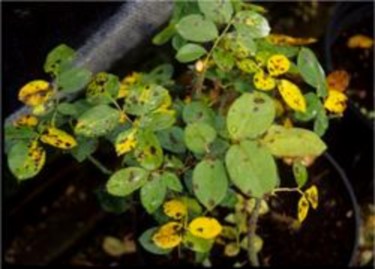
Figure 4.4. Rose plants infected blackspot
(Photo: urbanext.illinois.edu/roses/disease.cfm)
This fungal disease can cause almost complete defoliatiation of bushes by early fall, resulting in a weakened bush on which cane die-back and cankers become severe. Blackspot is identified as circular black spots that appear on the upper surface of the leaves, starting at the bottom of the plant and moving upward. Infected leaves turn yellow and fall off prematurely. The fringed margin and black color distinguish this leaf spot from others. Infections on canes are identified as reddish-purple spots. Splashing water spreads blackspot. Infection occurs after leaves are wet for several hours, making it more serious during rainy periods. Some roses are less susceptible than others, so cultivar selection is important. The fungus overwinters in fallen leaves and stem cankers. Raking and removing these leaves as well as pruning out affected canes by spring before the buds swell may help provide some control. Avoid wetting the leaves when watering and locate plants where there is good air circulation. Fungicide spray programs need to be started as soon as new leaves appear in the spring.
2.2. Powdery Mildew
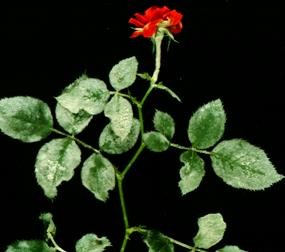
Figure 4.5. Rose plants infected powdery mildew.
(Photo: http://hort.uwex.edu/articles/powdery-mildew-trees-shrubs/)
Powdery mildew is a fungus disease that affects young leaves, causing them to curl and twist and develop a purple coloration. As the disease progresses, leaves become covered with white powdery fuzz. Whereas blackspot is usually most severe on the lower part of the plant, mildew affects the top part of the plant. Mature leaves are less likely to be affected. Mildew is spread by wind and develops rapidly during periods of warm, dry days followed by cool, humid nights. Infections of mildew are actually discouraged by the presence of water on the leaves. However, keeping plants wet all night to avoid mildew provides an environment that allows other diseases to develop. Infection can be reduced through sanitation and fungicide spray programs. Prune out all dead and diseased canes to reduce initial fungus infection. Because new growth is especially susceptible, thorough coverage of new growth with fungicide is important. Plant roses in areas where they receive good air circulation and where the foliage can dry off rapidly in the early morning to prevent many types of diseases.
Frequently used fungicides for control of powdery mildew.
2.3. Botrytis Blight
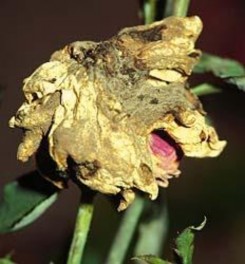
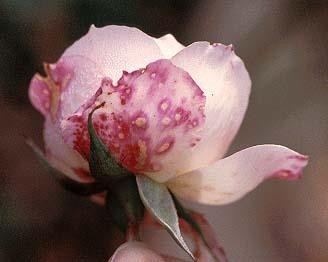
Figure 4.6. Rose plants infected botrytis blight
(Photo: http://www.sactorose.org/ipm/83botrytis.htm)
Botrytis blight is a fungal disease that generally attacks dying tissue. It is frequently found on older flowers and other plant parts. Under certain conditions it may also attack healthy tissue. Botrytis favors moist, wet conditions, often causing the disease to attack entire flowers and produce a gray fuzzy mold. This disease is often called gray mold. Good garden sanitation and removing spent flowers often result in good control of this disease. When this is insufficient in providing adequate control, a preventative spray program may be necessary.
Exercises:
Task 1: Read part 4.2 and match the statements with the corresponding diseases.
Blackspot (B) Powdery Mildew (PM) Botrytis Blight (BB)
1.is often called gray mold.
2.is usually most severe on the lower part of the plant.
3.affects the top part of the plant.
4.is able to attack healthy tissue.
5.is spread by wind and develops rapidly during periods of warm,
dry days.
6.appears on the upper surface of the leaves.
7.A fungal disease that generally attacks dying tissue.
8.Splashing water spreads the disease.
9.A fungus disease that affects young leaves.
10.Infected leaves turn yellow and fall off prematurely.
11.Leaves become covered with white powdery fuzz.
12. Infections of mildew are actually discouraged by the presence of water on the leaves.
Task 2: Refer part 4.2 and translate into Vietnamese.
1. Phenotypic resistance is when a cultivar is resistant to a disease in one location or part of the country but not in another. Genotypic resistance is due to the presence of genes that are not affected by climate, location, or horticultural practice.
……………………………………………………………………………….
2. Infection occurs after leaves are wet for several hours, making it more serious during rainy periods. Raking and removing these leaves as well as pruning out affected canes by spring before the buds swell may help provide some control.
……………………………………………………………………………….
3. Infection can be reduced through sanitation and fungicide spray programs. Prune out all dead and diseased canes to reduce initial fungus infection.
……………………………………………………………………………….
4. Botrytis favors moist, wet conditions, often causing the disease to attack entire flowers and produce a gray fuzzy mold. Good garden sanitation and removing spent flowers often result in good control of this disease.
……………………………………………………………………………….
UNIT 5: NUTRIENT DEFICIENCIES
MH35-05
Introduction
Plants can also suffer deficiencies where the growing conditions are poor and the plants are unable to take up nutrients present in the soil. Very acid or alkaline conditions, dryness and waterlogging can all make it difficult for plants to take up soil nutrients.
Objective:
By the end of the lesson, learners are able to:
+ Enhance reading skills through exercises of comprehension .
+ Scan for details to have exact decisions to statements and complete the information required.

1. Conception of nutrient deficiencies
Some garden soils and potting composts suffer from a lack of nutrient content, leading to deficiency symptoms in the plants growing in them. The early stages of symptom development are the best time for observing visible symptoms. It is of little value to observe plants when the symptoms of the disorder have become so severe that the plants are almost dead.
Plants can also suffer deficiencies where the growing conditions are poor and the plants are unable to take up nutrients present in the soil. Very acid or alkaline conditions, dryness and waterlogging can all make it difficult for plants to take up soil nutrients.
Nutrient deficiencies cause symptoms such as leaf yellowing or browning, sometimes in distinctive patterns. This may be accompanied by stunted growth and poor flowering or fruiting.
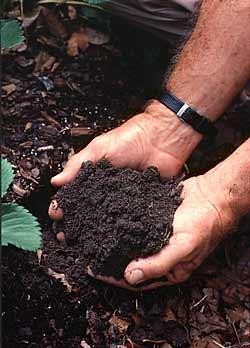
If plants fail to thrive, despite adequate soil preparation, watering and mulching, it may be a sign of a nutrient deficiency. Fruit and vegetables are particularly vulnerable, as are containerised plants and those growing in very acid or alkaline soils. Yellow or reddish coloured leaves, stunted growth and poor flowering are all common symptoms of nitrogen, magnesium or potassium deficiency.
Figure 5.1. Evaluating soil
(Photo: http://assoc.garden.org)
Exercises:
Task 1: Read part 5.1 and decide whether the statements are True (T) or False (F).
1.Lack of nutrient content in soil results from deficiency symptoms in the plants growing in them.
2.It is difficult for plants to take up soil nutrients in alkaline conditions.
3.The best time for observing visible symptoms is in the stages of symptom development.






